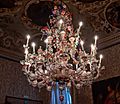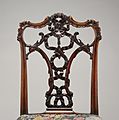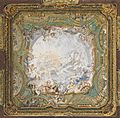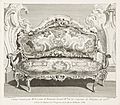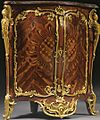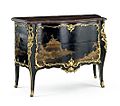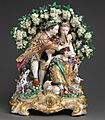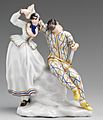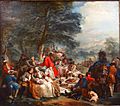Rococo facts for kids

Rococo is an artistic style which originated in the 18th century in France. Often referred to merely as Late Baroque, the Rococo developed from the Baroque artistic movement. Whilst it kept several characteristics of the original style, including elaboration and ornate themes, it was also more playful and asymmetrical. The Rococo is associated with the reign of French king Louis XV (Louis XIV is associated with the Baroque, whilst Louis XVI with Neoclassicism, albeit his style started off as Rococo at the beginning of reign). Rococo's popularity was at its height towards the middle of the 18th century, fading out by the end in favour of Neoclassicism.
Rococo art and architecture was feminine, graceful, florid and ornate. Creamy and pastel-like colours were used for paintings, unlike the darker shades in Baroque art. Religion and politics were no longer necessarily the core theme of Rococo art, unlike the Baroque, and everyday life became more commonly represented. In such a way, Rococo art revolved around themes such as love, romance, fun, landscapes, and mere portraits. Additionally, Far Eastern themes became popular in Rococo, especially Chinoiserie. Famous Rococo artists include Boucher, Watteau and Fragonard, amongst several others.
The Rococo has been the focus of much discussion, analysis and criticism by art historians throughout history. It has been criticised over the years for being over-the-top, superficial and frivolous; in such a way, the term has even been used derogatively in various points of history. Nevertheless, Rococo art and theatre has also received praise for the elegance, "beauty", and "charm" of its artwork.
Images for kids
-
Capital of the Engelszell Abbey, from Austria (1754-1764)
-
Frederick the Great, from Johann H. C. Franke, about 1781
-
Salon of the Hôtel de Soubise in Paris (1735–40) by Germain Boffrand
-
The door of the Hôtel de Marsilly, with two corbels and a cartouche above it, all of them being rococo
-
Eglise Notre-Dame, Bordeaux (1684-1707)
-
Amalienburg pavilion in Munich by François de Cuvilliés (1734–1739)
-
Hall of Mirrors of Amalienburg by Johann Baptist Zimmermann (1734–1739)
-
Looking up the central stairway at Augustusburg Palace in Brühl by Balthasar Neumann (1741–1744)
-
The Wieskirche by Dominikus Zimmermann (1745–1754)
-
Interior of the Basilica of the Fourteen Holy Helpers by Balthasar Neumann (1743–1772)
-
The Kaisersaal in the Würzburg Residence by Balthasar Neumann (1749–1751)
-
Festival Hall of the Schaezlerpalais in Augsburg by Carl Albert von Lespilliez (1765–1770)
-
Golden Cabinet of the Chinese Palace, Oranienbaum, Russia, built by Antonio Rinaldi for Catherine the Great (1762–1778)
-
Design for a State Bed by Thomas Chippendale (1753–54)
-
Proposed Chinese sofa by Thomas Chippendale (1753–54)
-
Side chair; Thomas Chippendale; circa 1755–1760; mahogany; Metropolitan Museum of Art (New York City)
-
Clock-chest for Frederick the Great (1742)
-
Antoine Watteau, Pilgrimage on the Isle of Cythera (1717)
-
"Luncheon with Ham" by Nicolas Lancret (1735)
-
Ceiling of the Salon of Hercules by François Lemoyne (1735)
-
Ceiling fresco in the Würzburg Residence (1720–1744) by Giovanni Battista Tiepolo
-
Ceiling of the Wieskirche by Johann Baptist Zimmermann (1745–1754)
-
Cupid by Edmé Bouchardon, National Gallery of Art (1744)
-
Atlantides in the upper Belvedere Palace, Vienna, by Johann Lukas von Hildebrandt (1721–22)
-
Assumption scene by Egid Quirin Asam (1722–23) former monastery church, Rohr in Niederbayern
-
El Transparente altar in Toledo Cathedral by Narciso Tomé (1721–32)
-
Portal of the Palace of the Marquis de Dos Aguas, Valencia, Spain (1740-1744)
-
Fountain of Neptune and Amphitrite Palace of Versailles, by Lambert-Sigisbert Adam and Nicolas-Sebastien Adam (1740)
-
The Music Lesson, Chelsea porcelain, Metropolitan Museum (c. 1765)
-
Cup with saucer; circa 1753; soft-paste porcelain with glaze and enamel; Los Angeles County Museum of Art
-
Church of São Francisco de Assis in Ouro Preto, Brazil, 1749–1774, by Aleijadinho
-
St. Andrew's Church in Kyiv, 1744–1767, designed by Francesco Bartolomeo Rastrelli
-
Eszterháza in Fertőd, Hungary, 1720–1766, sometimes called the "Hungarian Versailles"
-
Electoral Palace of Trier
-
Basilica of Santo Domingo in Lima, Peru, completed in 1766, by Manuel d'Amat i de Junyent
-
Antoine Watteau, Pierrot, 1718–1719
-
Antoine Watteau, Pilgrimage to Cythera , 1718–1721
-
Jean François de Troy, A Reading of Molière, 1728
-
Francis Hayman, Dancing Milkmaids, 1735
-
Charles-André van Loo, Halt to the Hunt, 1737
-
Gustaf Lundberg, Portrait of François Boucher, 1741
-
Giovanni Battista Tiepolo, The Banquet of Cleopatra, 1743
-
Maurice Quentin de La Tour, Full-length portrait of the Marquise de Pompadour, 1748–1755
-
François Boucher Portrait of the Marquise de Pompadour, 1756
-
Jean-Honoré Fragonard, The Swing, 1767
-
Jean-Honoré Fragonard, Inspiration, 1769
-
Jean-Honoré Fragonard The Meeting (Part of the Progress of Love series), 1771
-
Élisabeth Vigée-Lebrun, Marie Antoinette à la Rose, 1783
-
Jean-Baptiste-Siméon Chardin, Still Life with Glass Flask and Fruit, c. 1750
-
Jean-Baptiste Greuze, The Spoiled Child, c. 1765
-
Joshua Reynolds, Robert Clive and his family with an Indian maid, 1765
-
Angelica Kauffman, Portrait of David Garrick, c. 1765
-
Louis-Michel van Loo, Portrait of Denis Diderot, 1767
-
Thomas Gainsborough, The Blue Boy, 1770
-
Thomas Gainsborough, Portrait of Mrs Mary Graham, 1777
See also
 In Spanish: Rococó para niños
In Spanish: Rococó para niños















